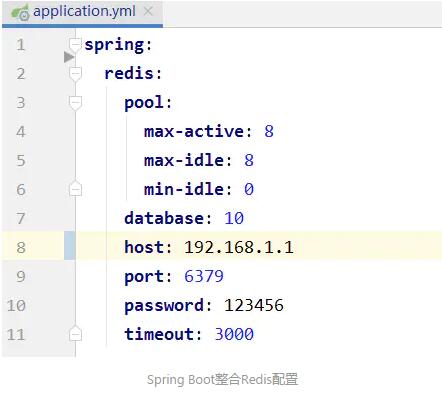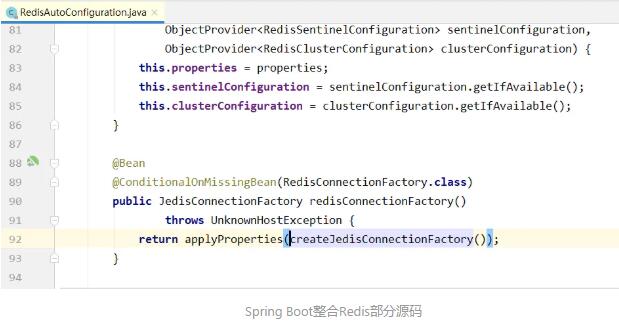首先項(xiàng)目A,也就是SpringBOOT項(xiàng)目中使用redisTemplate 來做REDIS的緩存時(shí),你會發(fā)現(xiàn)存到REDIS里邊的KEY和VALUE,redisTemplat使用jdkSerializeable存儲二進(jìn)制字節(jié)編碼
項(xiàng)目B中使用jedis時(shí),存儲起來的是字符串,導(dǎo)致項(xiàng)目A要調(diào)用項(xiàng)目緩存的鍵值對時(shí),獲取不到
解決方案:
修改項(xiàng)目A的redisTemplate的序列方式
|
1
2
3
4
5
6
7
8
9
10
11
12
13
14
15
16
17
18
19
20
21
22
23
24
25
26
27
|
@Configuration@EnableCachingpublic class RedisConfig extends CachingConfigurerSupport { /** * redis模板,存儲關(guān)鍵字是字符串,值是Jdk序列化 * @param factory * @return * @Description: */ @Bean public RedisTemplate<?, ?> redisTemplate(RedisConnectionFactory factory) { RedisTemplate<?, ?> redisTemplate = new RedisTemplate<>(); redisTemplate.setConnectionFactory(factory); //key序列化方式;但是如果方法上有Long等非String類型的話,會報(bào)類型轉(zhuǎn)換錯(cuò)誤; RedisSerializer<String> redisSerializer = new StringRedisSerializer();//Long類型不可以會出現(xiàn)異常信息; redisTemplate.setKeySerializer(redisSerializer); redisTemplate.setHashKeySerializer(redisSerializer); //默認(rèn)使用JdkSerializationRedisSerializer序列化方式;會出現(xiàn)亂碼,改成StringRedisSerializer StringRedisSerializer stringSerializer = new StringRedisSerializer(); redisTemplate.setKeySerializer(stringSerializer); redisTemplate.setValueSerializer(stringSerializer); redisTemplate.setHashKeySerializer(stringSerializer); redisTemplate.setHashValueSerializer(stringSerializer); return redisTemplate; }} |
補(bǔ)充:RedisTemplate初始化和創(chuàng)建(非Spring注入方式)
概述
在工作中, 可能會在非Spring項(xiàng)目(如Spark,Flink作業(yè))中去操作Redis, 重復(fù)造輪子去寫工具類沒有太大的意義, 使用RedisTemplate已經(jīng)足夠豐富和完善了,使用New的方式進(jìn)行創(chuàng)建即可, 不同的spring-data-redis的版本會略有不同, 下面以2.3.0和1.8.9做為示例.
2.3.0
maven
|
1
2
3
4
5
6
7
8
9
10
|
<dependency> <groupId>org.springframework.data</groupId> <artifactId>spring-data-redis</artifactId> <version>2.3.0.RELEASE</version></dependency><dependency> <groupId>redis.clients</groupId> <artifactId>jedis</artifactId> <version>3.3.0</version></dependency> |
代碼
|
1
2
3
4
5
6
7
8
9
10
11
12
13
14
15
16
17
18
19
20
21
22
23
24
25
26
27
28
29
30
31
32
33
34
35
36
37
38
|
import org.springframework.data.redis.connection.RedisClusterConfiguration;import org.springframework.data.redis.connection.RedisNode;import org.springframework.data.redis.connection.RedisStandaloneConfiguration;import org.springframework.data.redis.connection.jedis.JedisConnectionFactory;import org.springframework.data.redis.core.RedisTemplate;import org.springframework.data.redis.core.ValueOperations;import java.util.Collections;import java.util.List;import java.util.Objects;public class RedisTest { public static void main(String[] args) { //單機(jī)模式 RedisStandaloneConfiguration rsc = new RedisStandaloneConfiguration(); rsc.setPort(6379); rsc.setPassword("123456"); rsc.setHostName("192.168.1.1"); //集群模式 RedisClusterConfiguration rcc = new RedisClusterConfiguration(); rcc.setPassword("123456"); List<RedisNode> nodes = Collections.singletonList(new RedisNode("192.168.1.1", 6379)); rcc.setClusterNodes(nodes); RedisTemplate<String, String> template = new RedisTemplate<>(); //單機(jī)模式 JedisConnectionFactory fac = new JedisConnectionFactory(rsc); //集群模式 //JedisConnectionFactory fac = new JedisConnectionFactory(rcc); fac.afterPropertiesSet(); template.setConnectionFactory(fac); template.setDefaultSerializer(new StringRedisSerializer()); template.afterPropertiesSet(); ValueOperations<String, String> op = template.opsForValue(); final String key = "123_tmp"; final String value = "abc"; template.delete(key); op.set(key, value); assert Objects.equals(op.get(key), value); }} |
集群方式運(yùn)行報(bào)錯(cuò)
Exception in thread "main" redis.clients.jedis.exceptions.JedisDataException: ERR This instance has cluster support disabled
解決
在redis.conf下將cluster-enabled改為yes
如果只有一個(gè)節(jié)點(diǎn), 改為單機(jī)模式
1.8.9
maven
|
1
2
3
4
5
6
7
8
9
10
|
<dependency> <groupId>org.springframework.data</groupId> <artifactId>spring-data-redis</artifactId> <version>1.8.9.RELEASE</version></dependency><dependency> <groupId>redis.clients</groupId> <artifactId>jedis</artifactId> <version>2.9.0</version></dependency> |
代碼
|
1
2
3
4
5
6
7
8
9
10
11
12
13
14
15
16
17
18
19
20
21
22
23
24
|
import org.springframework.data.redis.connection.jedis.JedisConnectionFactory;import org.springframework.data.redis.core.RedisTemplate;import org.springframework.data.redis.core.ValueOperations;import redis.clients.jedis.JedisPoolConfig;import redis.clients.jedis.JedisShardInfo;import java.util.Objects;public class RedisTest { public static void main(String[] args) { RedisTemplate<String, String> template = new RedisTemplate<>(); JedisConnectionFactory fac = new JedisConnectionFactory(new JedisPoolConfig()); JedisShardInfo shardInfo = new JedisShardInfo("192.168.1.1", 6379); shardInfo.setPassword("123456"); fac.setShardInfo(shardInfo); template.setConnectionFactory(fac); template.setDefaultSerializer(new StringRedisSerializer()); template.afterPropertiesSet(); ValueOperations<String, String> op = template.opsForValue(); final String key = "123_tmp"; final String value = "abc"; template.delete(key); op.set(key, value); assert Objects.equals(op.get(key), value); }} |
這里有個(gè)小細(xì)節(jié), 如果不調(diào)用setShardInfo()方法, 那么需要執(zhí)行下面的代碼, afterPropertiesSet()用來初始化
|
1
2
3
4
5
|
JedisConnectionFactory fac = new JedisConnectionFactory(new JedisPoolConfig()); fac.setPort(6379); fac.setPassword("123456"); fac.setHostName("192.168.1.1"); fac.afterPropertiesSet(); |
說明
RedisTemplate的構(gòu)造方法有多種, 上面所舉例子為其中的一種; 不通過SpringBoot自動裝配的方式, 必須手動去執(zhí)行afterPropertiesSet()進(jìn)行初始化; 可參考SpringBoot整合redis的方式, 查看對應(yīng)實(shí)現(xiàn)


以上為個(gè)人經(jīng)驗(yàn),希望能給大家一個(gè)參考,也希望大家多多支持服務(wù)器之家。如有錯(cuò)誤或未考慮完全的地方,望不吝賜教。
原文鏈接:https://www.cnblogs.com/yvanBk/p/10497542.html















